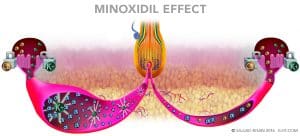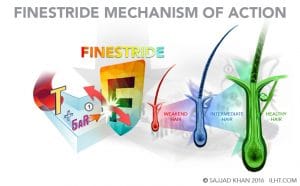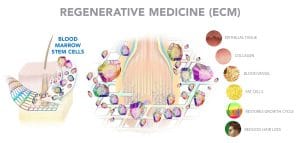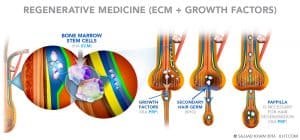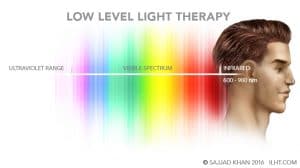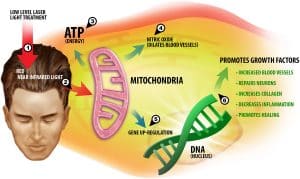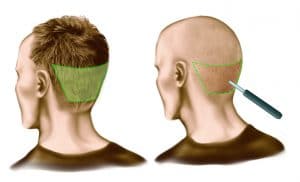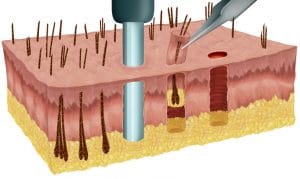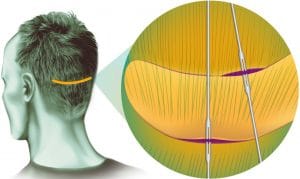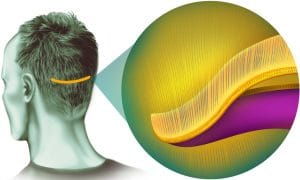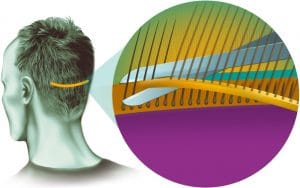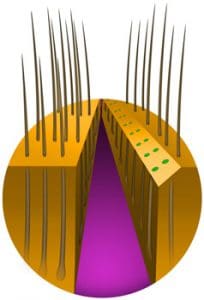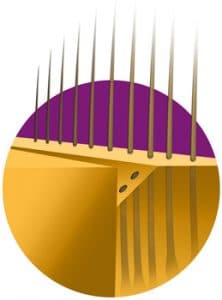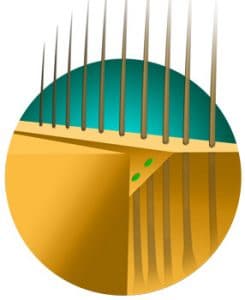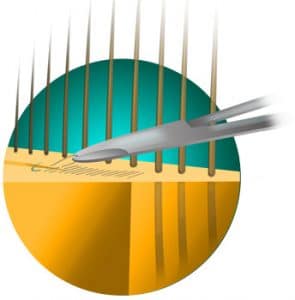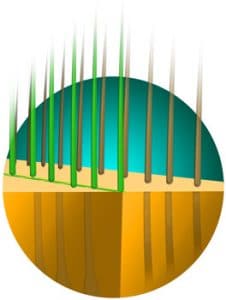Men Hair Loss Treatments For Long Lasting Androgenetic Male Pattern Hair loss
We can divide men hair loss treatments into two major types
- Medical treatments
- Surgical treatments
Medical Treatments
There are three classes of medical treatments.
- Topical Minoxidil
- Oral Anti-Androgen Finasteride
- Regenerative Treatments – ECM, PRP, and LLLT
Topical Minoxidil
It was approved for use as an Antihypertensive medicine, one of its side effect was hair growth. Minoxidil is a potassium channel opener and a vasodilator and is FDA approved for hair loss and is more effective in women.
- Minoxidil mechanism of action for an increase in hair growth is unknown.
- Minoxidil 5% solution or foam applied to the scalp twice a day, resulted with 45% of the men experiencing an increase in hair regrowth.
Side Effects: skin rash, increase in heart rate, dizziness, and swelling
Oral Anti-Androgen Finasteride
Finasteride is an inhibitor of type 2, 5-alpha reductase, which is located in the outer root sheath and dermal papilla of hair follicles, as well as in the prostate and the liver. Finasteride slows down the progression of hair loss and increases hair growth. Long-term, it is very safe.
In 1997 the FDA approved Finasteride—1 mg a day—for the treatment of hair loss in men. Finasteride’s mechanism of action directly addresses the root cause of androgentic male pattern hair loss.
Finasteride is an inhibitor of type 2, 5-alpha reductase, it reduces the production of DHT, and DHT-induced progressive miniaturization of hair is stopped. Once the effect of DHT induced miniaturization is stopped by Finasteride, the miniaturization process can get reversed. The thin vellus hair can become healthy terminal hair, especially in the crown area.
How To Use: Men who have mild to moderate baldness should take one 1mg tablet of Finasteride once a day.
Finasteride Side Effects:
Throughout our body, including brain, skin, and genitals—the androgenic signals are carried by di-hydro testosterone, DHT. Only for the skeletal muscles, testosterone is the main hormone. DHT is three times more potent than testosterone and is important for the development of secondary sexual characteristics. Throughout life, DHT is extremely important for physical and psychological strength and for optimal sexual functioning.
Testosterone can be converted to estrogen by aromatization process in the body. Once the DHT is formed it stay as DHT. DHT is anti-estrogen as well. DHT acts on the hypothalamus/pituitary gland to control testosterone and estrogen production.
Among the younger individuals,0.3% report loss of libido or erectile dysfunction. These sexual side effects increase to 3-5% in men who are more than 50 years of age. Mostly these side effects disappear once the finasteride is stoped. Prostate-specific antigen levels (PSA) and electrolyte levels should be measured before prescribing finasteride for hair loss to individuals who are above 40 years of age .
Post-Finasteride Syndrome
In few individuals the finasteride side effects can be persistent for longer duration even after discontinuation of the medicine. These side effects are loss of libido, erectile dysfunction, depression, suicidal ideation, anxiety, panic attacks, gynecomastia, muscle atrophy, cognitive impairment, insomnia, severely dry skin and tinnitus. At the first sign of any of the above side effects, discontinue the finasteride immediately and consult with your doctor.
Regenerative Treatments
ECM (Extra Cellular Matrix)
ECM is a type of Structural Scaffolding composed of various protein molecules such as laminin, collagen, and fibronectin, all woven together in a web-like geometry. ECM comes in powder form and mixed with normal saline. When it is injected into the scalp, it forms the structural scaffold and send the message to the bone marrow stem cells. Bone marrow stem cells move to the area of scaffold and scaffold act as a glue that holds the stem cell and get them to work and help regenerate the new blood vessel, collagen, fat cells, skin cells and these stem cells help the weaker hair cells to become stronger and restore the normal hair growth cycle.
PRP (Platelet Rich Plasma)
This process involves taking your own blood and centrifuge to concentrate and isolate the platelets and plasma from other blood cells. The concentrated platelets are activated, and they release many growth factors. The most important ones for regenerating the hair are,
- Insulin like growth factors ( regulate cell growth )
- Vascular endothelial growth factors ( regenerate new blood vessels )
- Keratinocytes growth factors ( regenerate new skin cell )
- Platelet derived growth factors ( regenerate collagen )
- Basic fibroblast growth factors ( regulate cell growth and collagen )
Isolated plasma contains fibrinogen and its activated to fibrin by calcium chloride. Activated platelets and plasma are injected into the scalp just below the skin level. Fibrin provide the scaffold and act as a glue that holds the growth factors and provide the platform to get them to work and help regenerate the new blood vessel, collagen, skin cells and regulate the cell growth and through activation of mesenchymal cells help the weaker hair papilla cells to become stronger and restore the normal hair growth cycle.
ECM and PRP can be injected into the scalp together and complement each other to help the weaker hair to become stronger.
LLLT (Low Level Light Therapy)
The existence of nearly all life on Earth is fueled by light from the Sun. Sunlight spectrum ranges mainly from ultraviolet to visible and infrared light. The ultraviolet radiation in sunlight has both positive and negative health effects, as it is both a principal source of vitamin D3 and skin cancers.
Application of lower dose of near infrared light promote tissue regeneration and reduce inflammation and referred as low-level light therapy LLLT. The LLLT is in the near infrared spectrum ( 600 mm to 1000 mm ). Typically, It is applied for a minute on alternate days.
LLLT affect mitochondria and result in increase ATP energy generation and through the release of reactive oxygen species induce transcriptional changes in DNA results in increased cell longevity, neo-vascularization, collagen synthesis and promote healing. LLLT also enhance nitric oxide, it induces localized vasodilation and provides more nutrient to the cells. This process may reverse the hair thinning and restore the normal hair growth cycle.
Surgical Treatments
Hair Transplant
Hair transplant is the only proven way to restore hair permanently onto the bald or thinning areas of the scalp. The procedure entails taking the hair from the back of the scalp, these hair are genetically different and are resistant to hair loss. The hair taken from the back of the scalp are relocated to the thinning or bald area, where they will continue to grow permanently.
There are two standardized hair restoration techniques
1-Follicular Unit Extractions referred as FUE, where single follicular units are punched out from the back of the scalp and relocated to a thinning or bald area.
2-Follicular Units Transplant referred as FUT, where hair bearing tissue is taken from the back of the scalp and individual follicular units are separated out from the tissue under the microscopes and these follicular units are transplanted in the thinning or bald area.
The type of hair restoration surgery is chosen based on the individual specific needs.
Hair transplant procedures are performed under local anesthesia to minimize the pain during the procedure.
Natural and permanent results of hair transplantation demand clinical expertise and as well as artistic creativity and ability on the part of surgeon.
Choosing The Right Surgical Technique
Presently there are two standardized techniques FUE, and FUT.
Follicular Unit Extraction (FUE )
Donor area is marked, a vertical line is drawn in front of the ear, behind this vertical line on the side and back of the Scalp about 2cm of healthy hair are left in the upper and the lower margins. The area within the above mentioned margins is considered the Donor area for FUE.
Follicular unit extraction requires the donor area be shaved. The donor area can be partially or completely shaved. If the Donor area is completely shaved, an average 2000-3000 follicular units can be extracted. If donor area is partially shaved in a way that top hair cover the shaved areas, in this situation an average 1000-1500 follicular units can be extracted. Special micro punches are used to punch out the follicular units. Motorized micro punches are faster than manual.
Different Micro Punches For FUE
- Manual Micro Punches
- Motorized Micro Punches
- Motorized Suction Punches
- Robotic Micro Punches
For follicular extraction doctors can choose any of the above punches depending on their preferences, the goal is to have minimum damage during FUE.
Advantages Of FUE
- Once the donor area heals, there is no noticeable scarring in the donor area.
- Client has the flexibility to wear the hair extremely short or even shave off the hair without the fear of any visible scarring in the donor area
Disadvantages Of FUE
- The micro punch is moved down over the follicular units to cut free the tissue around it, so the follicular unit is free to be extracted out with fine forceps. Due to not able to see clearly the hair direction in the scalp during this cutting process, there is an average 5% damage to the follicular units.
- The punching and extracting out process in FUE also can traumatize the follicular units, which can lead to poor hair survival.
- There is a limitation of an average 2000 to 3000 follicular units extraction in one surgery. Due to this limitation, most of the time multiple hair transplants are required. The desired coverage is achieved in an average two years time.
- If the donor area is shaved to extract maximum follicular units, extraction sites are visible for on an average 2 weeks time.
- In transplanted area, surgery is noticeable for an average 10-15 days.
- Due to noticeability of the tiny circular holes of follicular extraction sites in the donor area and transplanted look in the planted area, there is an average 10-15 days downtime to resume work.
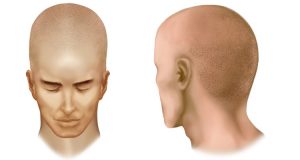
- If the donor area is partially shaved in a way top hair cover the area, then surgery is only noticeable in the transplanted area.
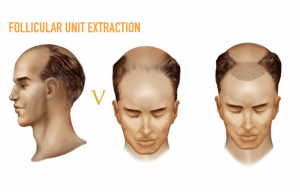
- There is temporary numbness feeling in the Donor and transplanted area.
- Chances of shock hair loss in the transplanted area. Hair lost due to shock grows back along the transplanted hair.
Reasons To Choose FUE
If the lifestyle of the client is to wear the hair very short like number 1 machine or keeping the hair shaved most of the time, FUE is the better choice of not having any visible scarring in the donor area.
Follicular Unit Transplant/Long Hair Technique
A horizontal line is marked In the middle of the donor area, leaving an equal amount of hair above and below the line in the donor area. Depending on the individual flexibility and laxity of the scalp, this marked line is stretched on an average from 1cm to 2.5 cm. An incision of an average 0.5 mm deep in the direction of hair is made at the upper and lower borders of the marked donor area.Skin hooks are used to open up the upper and lower incision. The incision margins are stretched by skin hooks without any cutting, there is no damage to the hair. The extracted hairs in the tissue are intact and non-traumatized.
Once the Donor tissue is out, there is an average 1-2 cm gap depending on the width of the extracted tissue and it has upper and lower skin margins. In any one of the skin margin, an average 1 mm wide and 3/4 mm deep superficial dermis is shaved, referred as Trichophytic Technique. In the tissue gap, ECM is laid for better healing. The upper and lower edges are fine stitched together. Hair grows out through the scar line because of Trichophytic technique and most of the time scar line becomes undetectable due to trichophytic closure.
The follicular units are separated under the microscopes from the extracted tissue. The average hair damage in FUT during tissue removal and separating and preparing follicular units under the microscope is from 0 to 0.4 % of the total number of hair.
Advantages of Long Hair Technique
- There is a damage of 0 – 0.4% in comparison with FUE damage of 5% in follicular units preparation. FUT follicular units are intact and non-traumatized with almost 100% survival.
- An average 5000 follicular units can be performed in one surgery. If the flexibility and density is good up to 8000 follicular units can be performed in one surgery.
- Higher follicular unit numbers and near 100% survival help to achieve client’s goals in one surgery.
- The donor hair is not shaved or trimmed, stitches are covered by one’s own hair.
- Trichophytic technique, fine stitch closure and use of ECM, leads to very fine line scar or unnoticeable scar. The area is covered by one’s own hair.
- The same length transplanted hair on the front keep the surgery sites unnoticeable.
- The long hair transplanted in the hairline give the preview of the future hairline and outcome.
- Follicular units can be readjusted if needed during the surgery depending on the initial look.
- There is no surgical downtime, the individual could resume the work next day without any surgical noticeability.
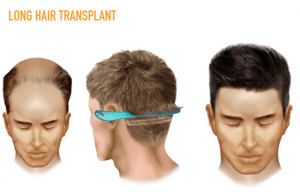
Disadvantages of Long Hair Technique
- If a person trims the hair extremely short like No 1 machine in the donor area or shaves off the hair, there are chances of noticeability of stitches marks or fine line scar in the donor area.
- Temporary numbness feeling in the donor area and transplanted area.
- Chances of shock hair loss in the transplanted area. Hair lost due to shock grows back along the transplanted hair.
Reasons To Choose Long Hair Technique
- If the lifestyle is to wear the hair half an inch or more in length most of the time, long hair technique is the absolute best choice.
- There is no surgical downtime, The individual can resume the work the very next day.
- This technique also provides complete coverage in a shorter amount of time than any other technique.


